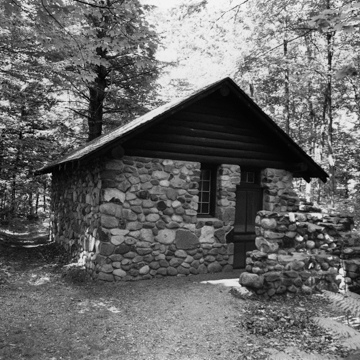Much of President Franklin Roosevelt’s acclaimed New Deal jobs program focused on conserving the nation’s natural resources. Among the first forests he designated was Nicolet National Forest in 1933. The following year, the U.S. Forest Service acquired the land along the sparkling waters of Franklin Lake that became the Franklin Lake Campground. The CCC, the WPA, and the U.S. Forest Service developed the campground cooperatively. The Forest Service provided architects, landscape architects, and engineers to design the buildings and develop the landscape plan. CCC enrollees planted trees and shrubs, constructed roads and trails, and established campsites. And WPA workers constructed the buildings and structures in a Rustic style that became standard for forests and parks. Designers blended buildings and structures with their surroundings by using indigenous natural materials, shingled roofs with broad overhangs, full-length porches, and overall simplicity.
The historic campground facilities nestle within a forest of maples, birches, pines, and hemlocks. They include a combination picnic shelter and bathhouse, a caretaker’s residence and garage, well houses, a reservoir building, a picnic shelter, comfort stations, and a storage building. Most resemble log cabins, but several are built of locally gathered stone. The most impressive of these is the combination building (1936), adjacent to the boat ramp. The two-story structure is set into a hill providing ground-level access to the first and second floors. From the east (away from the lake), the building appears one story tall, built of horizontal logs joined with saddle notches. An open middle section, marked by pairs of upright logs, suggests the passageways found in pioneer log cabins. On the west side of this passageway, an enclosed picnic area offers views of the lake through large unglazed openings. Below that level, uncoursed fieldstone forms the walls of the bathhouse (actually restrooms), as well as the stout chimneys at each gable wall. Inside, these chimneys become fieldstone chimney breasts. Fieldstone comfort stations (1936) scattered throughout the park have log gable ends and deeply inset windows accentuating the thickness of their stone walls.









